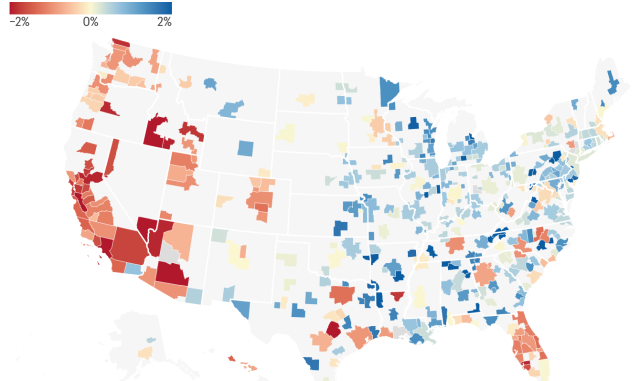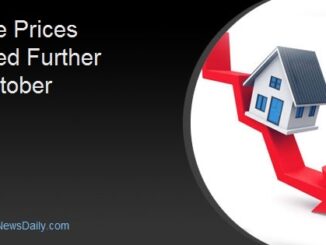
An updated analysis of Zillow Home Value Index data by Fortune (see chart below), finds that 38% of the nation’s 200 largest housing markets saw a month-over-month home price decline in February. That share has steadily declined over the past few months.
At the eight of the housing correction, 79% of the nation’s 200 largest housing markets saw a month-over-month home price decline in September. In October, 76% of those major markets saw a home price decline. In November and December, it was down to 64% and 67%, respectively. And by January, just 47% of the nation’s 200 largest housing markets registered a month-over-month home price decline.
What does this tell us? Well, the home price correction is losing steam—at least geographically speaking.
To better understand what’s happening in the U.S. housing market, Fortune built seven charts using the latest seasonally adjusted Zillow Home Value Index data. The index measures home values in the 35th to 65th percentile range (i.e. it looks at the middle of the market).
Let’s take a look at the updated data.
The U.S. housing market saw new- and existing-home sales fall at a historic pace in the second half of 2022 as the market adjusted to last year’s rise in mortgage rates.
This year, however, that free-fall in activity has stopped as the average 30-year fixed mortgage rate declined slightly, from 7.37% in early November to 6.57% as of Monday, and as we entered the seasonal spring period when demand increases. On the new home side, aggressive price cuts by builders coupled with incentives, like mortgage rate buy-downs, are helping builders increase sales.
The result? The home price correction has lost some steam. In September, home prices in 79% of major markets declined, compared to 38% in February. But that doesn’t mean national home prices have returned to growth mode. Indeed, nationally, home prices as measured by Zillow fell 0.02% in February.
Since peaking in June, U.S. home prices as measured by the seasonally adjusted Case-Shiller National Home Price Index are down 2.7% through December. Without seasonal adjustment, U.S. home prices are down 4.4% from their peak.
On one hand, the ongoing correction is the first national one since the housing crash bottomed out in 2012. On the other hand, the 2.7% decline is mild compared to the 26% decline that occurred between the market peak in 2006 and the bottom in 2012.
Unlike the 2008 era crash, this time around we neither have a glut of inventory (active listings in February 2023 were 37.6% below February 2020 levels) nor a subprime crisis.
Ultimately, analysts at firms like Fannie Mae and Moody’s Analytics expect a peak-to-trough decline of around 10%. While economists at Zillow and CoreLogic think national prices could bottom out this spring. That said, economists at all these firms acknowledge that peak-to-trough declines will vary significantly by market.
While the correction has lost steam, it’s still very much alive.
Through the first two months of 2023, the biggest home price drops were found in markets like Austin (down 2.5% since December), Boise (down another 2.4%), Las Vegas (down another 2.4%), Phoenix (down another 2.2%), and San Jose (down another 2.1%).
“We still think that there’s more [home] price correction to come on the resale side, though. And the resale market is always stickier to the downside when it comes to [home] prices,” Rick Palacios Jr., head of research at John Burns Real Estate Consulting, said in a video posted in February.
While many Western and Southern housing markets continue to inch down, many Midwestern and Northeastern markets continue to rise. That includes places like Chicago (up 0.6% since December) and Scranton, Pa. (up 2.4% since December). Unlike their Western and Southeastern peers, home prices in those markets didn’t become as detached from local income levels during the Pandemic Housing Boom.
Among the nation’s 400 largest housing markets tracked by Zillow, local home prices have fallen in 232 from their respective 2022 peaks. Of those down markets, home prices in 39 fell over 5.00% from their respective 2022 peaks. That includes places like Boise (down 8.9% from its peak), Austin (down 8.9%), and Phoenix (down 7.1%).
Still, prices still remain up on a year-over-year basis in most housing markets. The few exceptions are places like Boise, where prices fell 5.2% between Feb. 2022 and Feb. 2023.
This will change over the next few months. As hot months like February 2022 and March 2022 recede, more markets will go negative on a year-over-year basis. In fact, many housing analysts expect national home prices will be negative on a year-over-year basis by April.
That said, home prices are still up substantially since the pandemic’s onset.
During the Pandemic Housing Boom, from March 2020 to June 2022, U.S. home prices as measured by the seasonally adjusted Case-Shiller National Home Price Index skyrocketed 41.2%. Since then, national home prices have deflated 2.7%. That reduces remaining Pandemic Housing Boom gains to 37.4%.
Even the markets experiencing sharp declines are still up big-time.
Just look at Austin, where home prices in February were down 8.9% from their 2022 peak price, are still 44.4% above their March 2020 price.
Source: fortune.com



